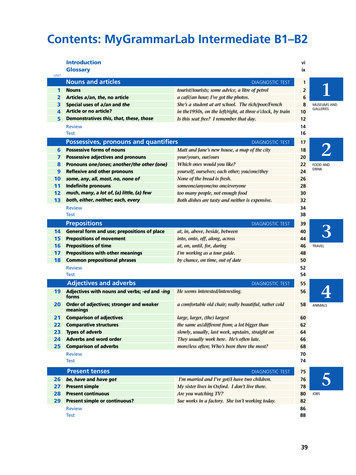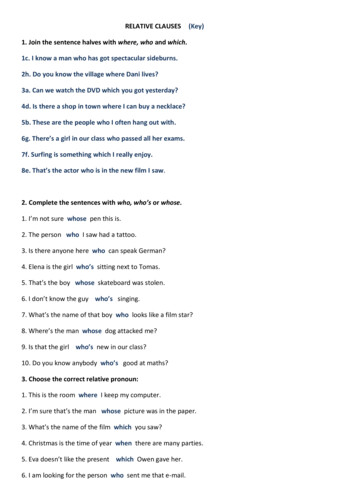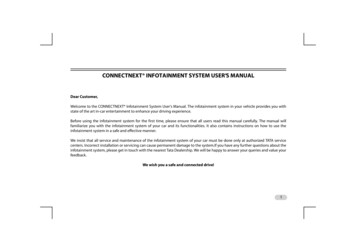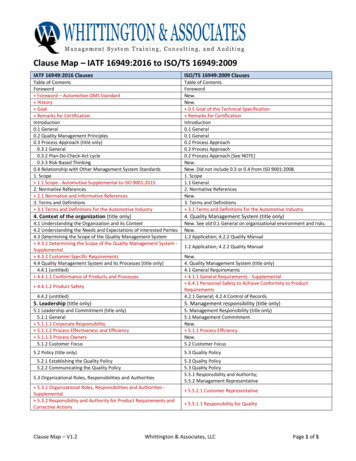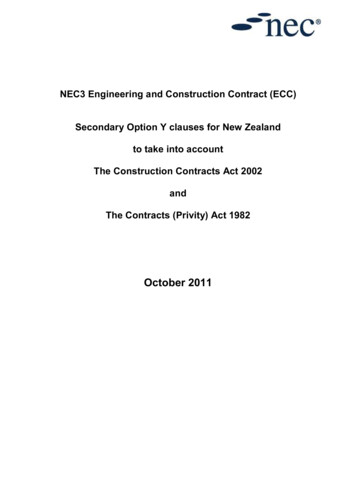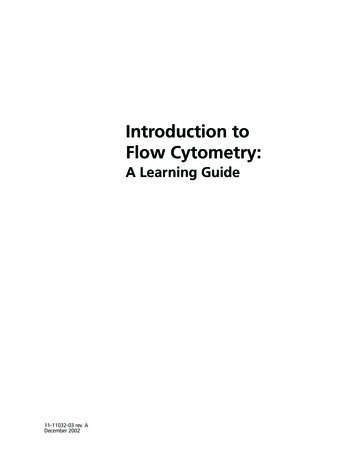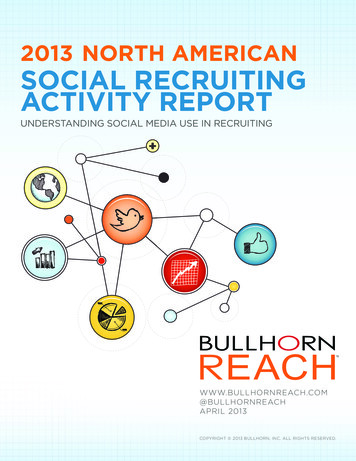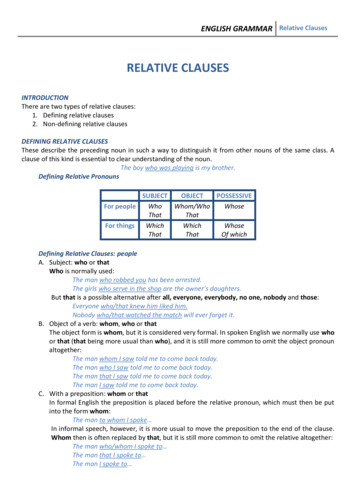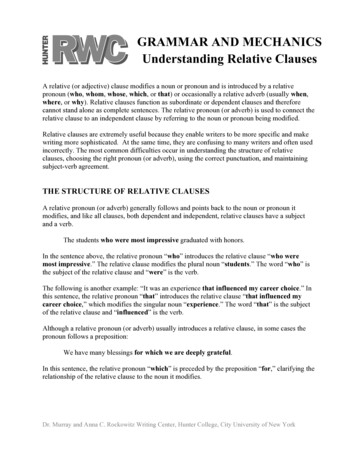
Transcription
GRAMMAR AND MECHANICSUnderstanding Relative ClausesA relative (or adjective) clause modifies a noun or pronoun and is introduced by a relativepronoun (who, whom, whose, which, or that) or occasionally a relative adverb (usually when,where, or why). Relative clauses function as subordinate or dependent clauses and thereforecannot stand alone as complete sentences. The relative pronoun (or adverb) is used to connect therelative clause to an independent clause by referring to the noun or pronoun being modified.Relative clauses are extremely useful because they enable writers to be more specific and makewriting more sophisticated. At the same time, they are confusing to many writers and often usedincorrectly. The most common difficulties occur in understanding the structure of relativeclauses, choosing the right pronoun (or adverb), using the correct punctuation, and maintainingsubject-verb agreement.THE STRUCTURE OF RELATIVE CLAUSESA relative pronoun (or adverb) generally follows and points back to the noun or pronoun itmodifies, and like all clauses, both dependent and independent, relative clauses have a subjectand a verb.The students who were most impressive graduated with honors.In the sentence above, the relative pronoun “who” introduces the relative clause “who weremost impressive.” The relative clause modifies the plural noun “students.” The word “who” isthe subject of the relative clause and “were” is the verb.The following is another example: “It was an experience that influenced my career choice.” Inthis sentence, the relative pronoun “that” introduces the relative clause “that influenced mycareer choice,” which modifies the singular noun “experience.” The word “that” is the subjectof the relative clause and “influenced” is the verb.Although a relative pronoun (or adverb) usually introduces a relative clause, in some cases thepronoun follows a preposition:We have many blessings for which we are deeply grateful.In this sentence, the relative pronoun “which” is preceded by the preposition “for,” clarifying therelationship of the relative clause to the noun it modifies.Dr. Murray and Anna C. Rockowitz Writing Center, Hunter College, City University of New York
TYPES OF RELATIVE CLAUSESThere are two types of relative clauses: restrictive and nonrestrictive. Each type has a differentfunction within a sentence and requires different punctuation.Restrictive Relative ClausesA restrictive relative clause defines or limits the meaning of the word it modifies, which makes itessential to the meaning of the sentence. Restrictive relative clauses are not set off by commas.Women who work are happier than women who don’t work.In the above sentence, the relative clauses “who work” and “who don’t work” are used to makethe noun “women” more specific. This type of relative clause changes the meaning of the noun itmodifies. In essence, women “who work” and those “who don’t work” represent two differentgroups of women. Without the appropriate relative clauses, this meaning would not be clear tothe reader.Here are some additional examples of sentences that show how a relative clause can change themeaning of a noun.Students learn a lot.Students who ask questions learn a lot.Teachers are unpopularTeachers who give a lot of assignments are unpopular.Nonrestrictive Relative ClausesA nonrestrictive relative clause describes a noun or pronoun whose meaning is already defined orlimited. As a result, the additional information is not essential and if the nonrestrictive elementwas removed it would not significantly change your understanding of the sentence.Going to the movies, which I love to do, can be very expensive.In the above sentence, the relative clause “which I love to do” modifies “Going to the movies,”but the additional information does not change the basic meaning of the sentence: Going to themovies can be very expensive.The following is another example: “Creativity, which may take many forms, is a quality allhuman beings have.” The relative clause “which may take many forms” modifies “Creativity,”but the additional information does not change the basic meaning of the sentence.Dr. Murray and Anna C. Rockowitz Writing Center, Hunter College, City University of New York
CHOOSING A RELATIVE PRONOUNThe three most common relative pronouns are who, which, and that, but the choice of pronoundepends upon the noun or pronoun modified by the clause.The relative pronoun “who”: refers to a person or peoplemay be used with a clause that makes a noun specific (a restrictive clause)may be used with a clause that adds information (a nonrestrictive clause)People who live in New York lead very busy lives.My sister, who works for the YMCA, leads a very active life.The relative pronoun “which”: refers to a thing or conceptis most often used in clauses that add informationis sometimes used in a clause that makes a noun specific (usually when a speaker orwriter wants to sound more formal)The Empire State Building, which used to be the tallest building in the world,is still a popular tourist attraction.The relative pronoun “that”: most often refers to a thing or conceptis used only in clauses that make a noun more specificis sometimes used to refer to a person or people (usually only in informal writing or inspeaking)The lessons that we have learned are no more important than the lessons that wehave yet to learn.In academic or formal writing, the relative pronoun “who” is preferred when referring toa person or people: “The girl who lives next door was accepted into the nursingprogram.” However, some writers as well as speakers will interchange “who” with“that.” It is best to use “that” when referring to things or concepts with the exception ofa group or class of people.The favorite to win the tournament was the team that was disqualified.Selection of the jury that would hear the case was time consuming.The class that scored highest on the exam was acknowledged by the administration.Dr. Murray and Anna C. Rockowitz Writing Center, Hunter College, City University of New York
The relative pronouns “where” and “when”: are used for a clause that refers to a place or timemay be used for clauses that make a noun more specificmay be used for clauses that add informationNew York is a place where people of many different cultures live and worktogether.New York City, where millions of immigrants live, is sometimes called aMelting Pot.The 1960s was a time when many Americans began to question the actions oftheir government.In the 1970s, when many new rights and freedoms had been gained, peoplebegan to lead quieter, more private lives.CHOOSING BETWEEN WHO, WHOM, AND WHOSEIn academic or formal writing, the relative pronouns who (or whoever), whom (or whomever),and whose are used to refer to people. The appropriate word choice is determined by thegrammatical function of the pronoun within the clause. Using the relative pronoun “who” or “whoever”:If the relative pronoun functions as a subject or subject complement, use “who” or “whoever”:I know a woman who has two children.In the sentence above, “who” introduces a restrictive relative clause that modifies the word“woman” and functions as the subject of the clause and “has” is the verb.The director will choose whoever has the best audition.In this sentence, “whoever” is the subject of the verb “has” and introduces the relative clause. Using the relative pronoun “whom” or “whomever”:If the relative pronoun functions as the object of a verb or preposition, use “whom” or“whomever”:My friend has two children, whom she loves very much.In this sentence, “whom” replaces “children” as the object of the verb “loves” and introduces anonrestrictive relative clause.Dr. Murray and Anna C. Rockowitz Writing Center, Hunter College, City University of New York
I will support whomever the committee recommends for the position.This sentence includes a restrictive relative clause introduced by the pronoun “whomever,”which is the object of the verb “recommends.” Using the relative pronoun “whose”:If the relative pronoun functions as a means to show possession, use “whose.”She was a distinguished public servant, whose reputation was impeccable.In this sentence, the relative pronoun “whose” replaces the pronoun “she” to form anonrestrictive relative clause: i.e., her reputation was impeccable.PUNCTUATING RELATIVE CLAUSESMany writers find it difficult to know when and how to use punctuation with relative clauses, soit is important to develop a strategy to guide your understanding.If a relative clause defines or identifies the noun or pronoun it modifies, punctuation is notrequiredThe woman who is sitting next to me wants to ask a question.In this sentence, the clause “who is sitting next to me” identifies a particular woman (the onesitting next to me) and functions as a restrictive relative clause.If the relative clause adds extra information or facts about the noun or pronoun, then the clausemust be set off from the rest of the sentence by commas:George Washington, who was the first president of the United States, is asymbol of honesty, bravery, and patriotism.In this sentence, “George Washington” is a proper noun identified by name, and the relativeclause “who was the first president of the United States” adds additional information that isnot essential to the meaning of the sentence. As a nonrestrictive relative clause, it is set off withcommas.If a relative clause adding extra information comes between a subject and a verb, there must be acomma before and after the clause. In essence, the punctuation indicates that the relative clausecould be removed and the basic sentence would remain the same.Dr. Murray and Anna C. Rockowitz Writing Center, Hunter College, City University of New York
SUBJECT-VERB AGREEMENT IN RELATIVE CLAUSESRelative pronouns connect a subordinating or dependent clause to an antecedent noun or pronounin a sentence. It is important therefore that relative pronouns used as subjects in relative clausestake verbs that agree with their antecedents. In addition, relative clauses contain a subject andverb as well as an object or complement. Subject-verb agreement within the clause is determinedby asking whether the antecedent of a subject relative pronoun is singular or plural.I met a man who works for the New York City Housing Authority.In this sentence, the relative pronoun “who” replaces the singular noun “man,” so the verb“works” agrees with a singular noun and takes an “-s” ending.I have several friends who work at the United Nations.In this sentence, the relative pronoun “who” replaces the plural noun “friends,” so the verb“work” agrees with a plural noun in simple present tense.TROUBLESHOOTINGWhen a relative clause immediately follows the subject of the independent clause, it is placedbetween the noun or pronoun and the verb of the sentence.People who have young children don’t always have much time for themselves.My parents, who live in Minneapolis, come to visit twice a year.In your own writing, when the relative clause immediately follows the subject of the sentence, itis easy to forget to finish the independent clause by adding the main verb after using the clause,which can result in a sentence fragment: “My sister who went to school in Albany.” In order tocorrect the fragment, add a main verb: “My sister, who went to school in Albany, is a nurse.” oromit the relative clause: “My sister went to school in Albany.”Dr. Murray and Anna C. Rockowitz Writing Center, Hunter College, City University of New York
GRAMMAR AND MECHANICS Understanding Relative Clauses A relative (or adjective) clause modifies a noun or pronoun and is introduced by a relative pronoun (who, whom, whose, which, or that) or occasionally a relative adverb (usually when, where, or why). Relative clauses f
